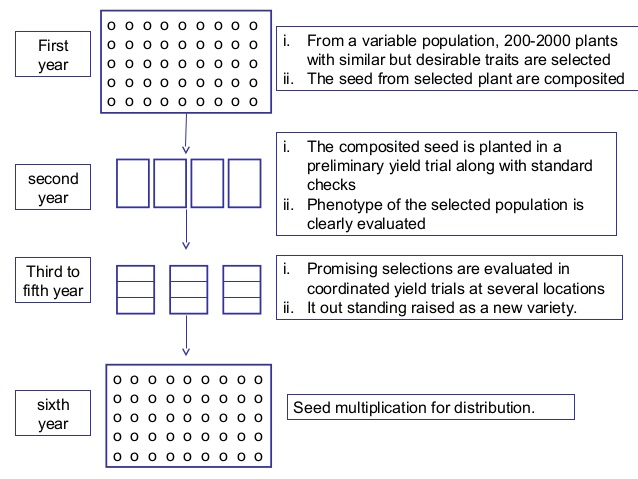MASS SELECTION
- Mass selection consists of selecting individuals on the basis of phenotypic superiority and mixing the seeds for using as planting material for next season.

a) Procedure for evolving variety by mass selection:
- First year : large number of phenotypically similar plants having desirable characters are selected. The number may vary from few hundred to few thousand. The seeds from the selected plants are composited to raise the next generation.
- Second year : composited seed planted in a preliminary field trial along with standard checks. The variety from which the selection was made should also be included as check. Phenotypic characteristics of the variety are critically examined and evaluated.
- Third to sixth year : The variety is evaluated in coordinated yield trials at several locations. It is evaluated in an initial evaluation (IET) trial for one year. If found superior it is promoted to main yield trials for 2 or 3 years.
- Seventh year : if the variety is proved superior in main yield trials it is multiplied and released after giving a suitable name.
b) Modification of mass selection:
- Large number of plants are selected (I year) and individual plant progenies are raised (II year).
- Inferior, segregating progenies are reflected. Uniform, superior rows are selected and the seed is bulked.
- Preliminary yield trials are conducted in third year. Fourth to seventh year multilocation tests are conducted and seed is multiplied in eight year and distributed in ninth year.
Merits of Mass selection
- Can be practiced both in self- and cross-pollinated crops
- The varieties developed through mass selection are more widely adopted than pure lines.
- It retains considerable variability and hence further improvement is possible in future by selection
- Helps in preservation of land races
- Useful for purification of pure line varieties
- Improvement of characters governed by few genes with high heritability is possible.
- Less time consuming and less expensive.
Demerits of mass selection
- Varieties are not uniform.
- Since no progeny test is done, the genotype of the selected plant is not known.
- Since selection is based on phenotype and no control over pollination the improvement brought about is not permanent. Hence, the process of mass selection has to be repeated not and then.
- Characters which are governed by large number of genes with low heritability cannot be improved.
- It cannot create any new genotype but utilizes existing genetic variability.
Achievements
Cotton : Dharwad American Cotton
Groundnut : TMV-1 & TMV-2
Bajra : pusa moti, Baja puri, Jamnagar gaint, AF3
Sorghum : R.S. 1
Rice : SLO 13, MTU-15
Potato : K122